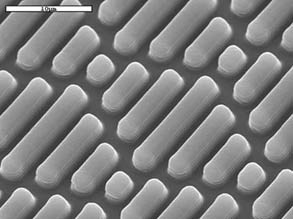|
|
Sharks Provide Inspiration for Ship Coatingsdownloadable pdfUniversity of Florida engineers have developed an environmentally friendly coating for hulls of oceangoing ships based on an unlikely source of inspiration: the shark. UF materials engineers tapped elements of sharks’ unique scales to design the new coating, which prevents the growth of a notoriously aggressive marine algae and may also impede barnacles, according to preliminary tests. If more extensive testing and development bear out the results, the shark-inspired coating — composed of tiny scale-like elements that can actually flex in and out to impede growth — could replace conventional antifouling coatings that leach poisonous copper into the ocean.
“The copper paints are wonderful in terms of keeping the ship surface clean, but they are poisonous and they accumulate at substantial rates in harbors,” threatening marine life, said Anthony Brennan, a UF professor of materials science and engineering and the lead developer of the coating. “By contrast, there are no toxins associated with our surface.” Brennan’s project is being sponsored by the U.S. Navy, the world’s largest maritime ship owner, which has contributed at least $750,000 to the effort so far. According to the Navy, algae and barnacles on hulls increase drag, slowing ships and reducing fuel efficiency. Of the $550 million to $600 million the Navy spends annually on powering its ships and submarines, at least $50 million stems directly from fouling-related increased drag, said Stephen McElvany, a program officer in environmental quality in the Navy’s physical science division. Brennan realized that sharks remain largely free of plants and barnacles despite spending their entire lives submerged. That contrasts with, for example, some other large-bodied marine species such as whales, which attract marine growth. Sharks have placoid scales, which consist of a rectangular base embedded in the skin with tiny spines or bristles that poke up from the surface — the reason a shark’s skin feels rough to the touch. Brennan decided to try mimicking that surface with an artificial coating to see if it would also have antifouling properties. His first product: a combination plastic/rubber coating that a microscope reveals is made of billions of tiny raised diamond-shaped patterns. Each “shark-let” diamond measures 15 microns, or 15 thousandths of a millimeter, and contains seven raised ribs that at close examination resemble different lengths of raised horizontal bars. Laboratory tests show that the coating prevents a very common and detrimental type of algae, called Ulva, from becoming established because the algae’s spores have great difficulty attaching to the diamond-shaped configuration. The algae is a major problem for nuclear submarines, carriers and battleships because it accumulates on inlet ports used to cool nuclear reactors. McElvany called the finding “exciting,” saying Brennan and his colleagues’ research “is both unique in their approach and exciting in terms of their efficacy” in deterring the Ulva spores. “The big hurdles that remain are to develop textures, patterns or chemistry on the surface that will also inhibit the settlement of a wide variety of the main marine foulers, such as barnacles,” he said. The UF team, which also includes UF research scientist Ron Baney and numerous graduate students, hopes to achieve that goal with its latest version of the coating. In research recently patented, Brennan and his colleagues have made the diamond-shaped pattern dynamic, or changeable, under the influence of a low-power electric current. The ribs on the surfaces swell and shrink — in effect flexing in and out from the hull surface — as the current varies. That may be useful because the movement could prevent the accumulation of silt and other debris on the hulls, which is often a precursor to plant and barnacle growth, he said. Both the original and newer versions of the coatings are being tested in labs in Florida, England, Hawaii, California and Australia, with full-scale ocean testing set to begin in March, Brennan said. The diversity of locations is important because each has different species of fouling plants and barnacles. Anthony Brennan, abrennan@mse.ufl.edu Aaron Hoover
|

